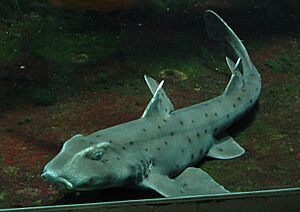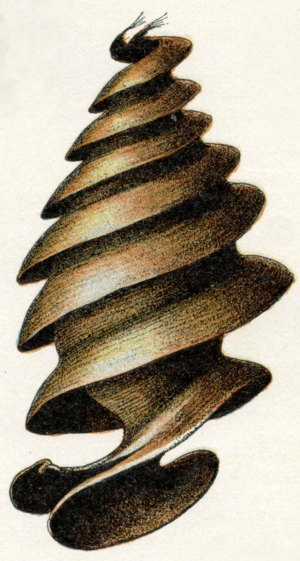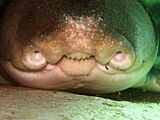Bullhead shark facts for kids
Quick facts for kids Bullhead shark |
|
|---|---|
 |
|
| Horn shark, Heterodontus francisci | |
| Scientific classification |
|
| Kingdom: | Animalia |
| Phylum: | Chordata |
| Clade: | Eugnathostomata |
| Class: | Chondrichthyes |
| Superorder: | Galeomorphii |
| Order: | Heterodontiformes |
| Family: | Heterodontidae J. E. Gray, 1851 |
| Genus: | Heterodontus Blainville, 1816 |
| Type species | |
| Squalus portusjacksoni F. A. A. Meyer, 1793
|
|
| Species | |
|
See text |
|
The bullhead sharks are a special group of sharks. They belong to the genus Heterodontus. These sharks are the only living members of their family, called Heterodontidae. They are also the only ones in their larger group, the Heterodontiformes.
Bullhead sharks are not very big. The largest species grows to about 1.65 meters (5.4 feet) long. They like to live near the ocean floor. You can find them in warm, tropical, and subtropical waters around the world.
Scientists have found fossils of these sharks from a very long time ago. Their ancestors lived during the Early Jurassic period. This was millions of years ago! All the bullhead sharks we see today came from one ancient ancestor. This ancestor survived a huge event called the Cretaceous-Paleogene extinction. New types of bullhead sharks started appearing around the middle of the Eocene epoch.
Contents
What Do Bullhead Sharks Look Like?
Bullhead sharks have bodies that get narrower towards the tail. Most species are about 70 to 130 centimeters (2.3 to 4.3 feet) long. Their skin comes in many colors. You might see them in shades of grey, brown, or even red. They often have cool patterns like spots and stripes.
They have big, blunt heads. Their mouths are quite small, but their nostrils are large. You can also see clear ridges right above their eyes. These sharks have two strong dorsal fins on their back. The first one is bigger than the second. Each dorsal fin has a stiff spine at its front. They also have an anal fin near their tail. Their tail fin is large, with a top and bottom part separated by a small dip.
One interesting thing about bullhead sharks is their teeth. They have different kinds of teeth! The teeth at the front are sharp and pointed. These are for grabbing prey. The teeth at the back are flat. They use these flat teeth to crush hard food. Their eggs are also unique, shaped like a spiral.
Where Do Bullhead Sharks Live and What Do They Eat?
Bullhead sharks prefer to live in coastal areas. They usually stay in waters shallower than 100 meters (330 feet). They are mostly active at night, hunting for food when it's dark.
These sharks eat a variety of things. They use a special way of eating called suction feeding. This means they suck their prey into their mouths! Their diet includes many invertebrates. They eat hard-shelled creatures like crabs and sea urchins. They also enjoy soft-bodied animals such as octopuses. Sometimes, they even eat smaller fish.
Remember those flat teeth at the back of their mouths? They use them to crush hard-shelled prey. Young bullhead sharks, called juveniles, usually eat softer foods than adult sharks. Their sharp fin spines help protect them. These spines make it harder for other predators to eat them.
Life Cycle and Reproduction
Bullhead sharks have very unique egg cases. They are shaped like a corkscrew or an auger. These spiral shapes help the eggs get stuck in cracks and crevices on the rocky seafloor. This protects the eggs from hungry predators. However, some bullhead sharks lay their eggs on sponges or seaweed instead.
When the baby sharks hatch, they are quite large for shark pups. They can be over 14 centimeters (5.5 inches) long when they leave the egg case. The eggs usually take about 7 to 12 months to hatch. This time can vary depending on the specific shark species.
Interestingly, female Japanese bullhead sharks sometimes lay their eggs together in one spot. This shared area is like a "nest" for their eggs. The Mexican hornshark has an egg case with a special tendril. This tendril helps anchor the egg case, rather than just wedging it into rocks.
Types of Bullhead Sharks
There are ten known living species of bullhead sharks. Each one has its own unique features! Here are some of them:
- Heterodontus francisci (Girard, 1855) (horn shark)
- Heterodontus galeatus (Günther, 1870) (crested bullhead shark)
- Heterodontus japonicus (Maclay & W. J. Macleay, 1884) (Japanese bullhead shark)
- Heterodontus marshallae White, Mollen, O'Neill, Yang & Naylor, 2023 (painted hornshark)
- Heterodontus mexicanus (L. R. Taylor & Castro-Aguirre, 1972) (Mexican hornshark)
- Heterodontus omanensis (Z. H. Baldwin, 2005) (Oman bullhead shark)
- Heterodontus portusjacksoni (F. A. A. Meyer, 1793) (Port Jackson shark)
- Heterodontus quoyi (Fréminville, 1840) (Galapagos bullhead shark)
- Heterodontus ramalheira (J. L. B. Smith, 1949) (whitespotted bullhead shark)
- Heterodontus zebra (J. E. Gray, 1831) (zebra bullhead shark)
-
A Port Jackson shark, Heterodontus portusjacksoni
-
Zebra bullhead shark, Heterodontus zebra
See also
- List of prehistoric cartilaginous fish





